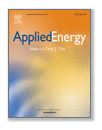Design of a 2 MW ZrC/W-based molten-salt-to-sCO2 PCHE for concentrated solar power
Abstract

To increase the power cycle efficiency and lower the levelized cost of electricity (LCOE) of concentrated solar power (CSP) plants, printed circuit heat exchangers (PCHEs) capable of operating above 700 °C with molten chloride salt and a sCO2-based fluid are needed. In this paper, the design of a high-pressure, high-temperature, 2 MW PCHE comprised of a thermomechanically-robust, zirconium carbide/tungsten (ZrC/W) composite is conducted for CSP plants. The ZrC/W composite is a material with high thermal conductivity, high stiffness, and high failure strength at high temperatures, along with excellent resistance to thermal cycling and thermal shock. In this work, a thermomechanical design analysis was conducted to select appropriate material thicknesses of the ZrC/W plates, and to determine the geometrical dimensions and the thermal performance of the PCHE. The influences of the plate number and heat exchanger length on power density and pressure drop have also been systematically investigated. Economic analyses were conducted to compare the cost of ZrC/W-based PCHEs to those comprised of IN740H (a state-of-the-art, nickel-based superalloy) and 316 stainless steel (316SS). At a sufficiently high plate production rate, the manufacturing cost of ZrC/W-based PCHEs can be significantly lower, while achieving a much higher power density, compared with state-of-the-art, nickel alloy-based and stainless steel-based PCHEs.
